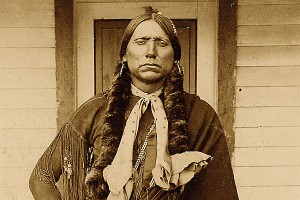Frankel, Glenn. The Searchers: The Making of an American Legend, Bloomsbury, New York, 2013 (405pp. $28)
The Parker clan were Baptist revivalists, part-time rustlers and small-scale con men who pulled up stakes in the Appalachians and headed for Texas, a Mexican backwater where a lack of law courts and free land beckoned.
They were crazy, sneaky and smart, and by the mid-1830s had built a compound on the edge of Comancheria in northwest Texas, where they grew corn, raised scrawny cattle and preached a fiery brand of Bible-thumping Christianity.
These two dozen ornery whites were living in the midst of an Indian nation stretching some 600 miles north to south from Kansas and the headwaters of the Arkansas River to the Rio Grande, and 400 miles east to west from Oklahoma and New Mexico to east Texas. Flat, waterless and treeless Comancheria had no signs, roads, fences or walls, an egg-shaped no-man’s-land where a dozen or so Indian bands (“Honey-Eaters,” “Those Who Turn Back”) operated free-range butchery, conducting the kind of compelling traditional warfare against their Mexican and American enemies that curdled the blood.
On May 19, 1836, Comanches attacked the James Parker stockade and half a dozen small cabins, killing Elder John Parker with a blow to the head with an axe, spearing his wife Sally, and riding down three others, before abducting four Parker children, one of whom was Cynthia Ann Parker, perhaps the most famous white woman Indian captive in American history though there were hundreds of others.
At the heart of Glenn Frankel’s new book, “The Searchers,” is not the uber-myth about America’s winning of the West or the gun-fighter nation, but instead the fate-worse-than-death myth, which abandons a captured white woman to the savages once she has been raped.
Frankel, whose reporting from the Middle East for the Washington Post won a Pulitzer Prize, writes eloquently about Comanche history and American cinema, viewing the fate myth simultaneously through the lens of film criticism and historical investigation, bringing into view not only our collective social reaction to the “captured maiden<” but also recapitulating a film classic, John Ford’s 1956 “The Searchers.”
In Hollywood’s re-telling of the Cynthia Ann Parker myth from the viewpoint of her uncle—the classic searcher for his niece—James became Ethan, played by John Wayne.
Frankel’s “The Searchers” recounts the history of the Comanche wars, their gut-wrenching final battles and the reduction of the tribe to reservation lackeys, led by the legendary Quanah Parker, Cynthia’s son, who died in 1911 surrounded by white sycophants and Indian relatives.
Frankel’s new research certainly pays dividends, but the book gets really rolling when he investigates and re-evaluates the film direct by Ford, an independent producer and director of no mean accomplishment (including a number of Academy Awards), perhaps best known for his “discovery” of the major star qualities of Wayne in the 1939 movie, “Stagecoach.”
Beginning with the screenwriters, sometime producer/director and pup Western author Alan LeMay (whose book was purchased by Ford’s company), “The Searchers is a fascinating blow-by-blow account of how a film gets made form a myth. For anyone remotely interested in Western history or Film, Frankel’s book is an invaluable, insightful and even momentous discussion, piecing together as it does the business and artistic ends of the movies lending the reader an insider’s eye to th machinations of cinema.
By any account, Ford was a bully, sadist, drunk and genius. He tormented his stock players, including Wayne, who was often the silent butt of Ford’s cruel attacks. Everybody seemed to suffer him—his son Patrick, who labored on the set as a production assistant; John Nugent, the talented screenwriter whose script was ostensibly perfect (until changed at every turn by Ford); and the actor Harry Carey Jr.
Ford’s script transformed the original James Parker of the 1830s and his quest to rescue Cynthia Ann into “Uncle Ethan” of 1868, hauntingly and brilliantly acted by Wayne, who will murder the captive “Debbie” because she has married a savage. Naturally, the biggest star of the film was Monument Valley, Ford’s epic landscape.
The film was delayed in release by Warner Brothers, which didn’t quite know whether it was a John Wayne Western or something “bigger”, then decided that it was a John Wayne Western, after all.
Many critics consider it flawed, though beautiful; racist in its treatment of Indians; and marred by continuity mistakes and historical lapses. The French (who else?) consider it an American masterpiece and supreme example of the auteur approach, while many major American directors, including Martin Scorsese, consider “The Searchers” a major inspiration.
Nobody now doubts that it is cinematic art, combining moral ambiguity with an epic VistaVision format a piece of work that despite its technical flaws (including some scenes played inappropriately for laughs), is more than just a Western movie. Frankel is acute about how all that works.
“The Searchers” is a beautifully-made book, marred only by an overly long “Epilogue” concerning the family get-togethers of the Parkers, white and Indian, a few geographical missteps, and the lack of a good map. But it is a treasure and a delight to read, both for history fans and film buff


